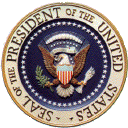 [National
Security Decision Directives]
[National
Security Decision Directives]
The White House NATIONAL SECURITY DECISION
WashingtonFebruary 25, 1985
DIRECTIVE NUMBER 164National Security Launch Strategy
NSDD 144, National Space Strategy, states that the Space Transportation System (STS) will continue as the primary space launch system for both national security and civil government missions. It also directs DoD to pursue an improved assured launch capability that will be complementary to the STS. This NSDD provides a launch strategy to implement these two provisions, as well as initiate a study to look toward the future development of a second-generation space transportation system.
The National Aeronautics and Space Administration (NASA) and the Department of Defense (DoD) will work together to insure that the STS is fully operational and cost-effective at a flight rate sufficient to meet justified needs. (The target rate is 24 flights per year.)
The Air Force will buy ten expendable launch vehicles (ELVs) and will launch them at a rate of approximately two per year during the period 1988-92. A competitive decision will be made between a Titan derivative vehicle and the SRB-X before March 1, 1985.
DoD will rely on the STS as its primary launch vehicle and will commit to at least one-third of the STS flights available during the next ten years. NASA and DoD will jointly develop a pricing policy for DoD flights that provides a positive incentive for flying on the Shuttle. The pricing policy will be based upon the principle that an agreed reimbursement rate per flight will be comprised of a fixed and variable component. This will result in an annual fixed fee and a charge per flight at marginal or incremental costs. NASA will propose a pricing policy based upon this principle by April 15, 1985.
DoD and NASA will jointly study the development of a second-generation space transportation system - making use of manned and unmanned systems to meet the requirements of all users. A full range of options will be studied, including Shuttle-derived technologies and others. It would be anticipated that NASA would be responsible for systems management of civil manned systems and DoD would be responsible for systems management of unmanned systems. DoD and NASA will jointly define the terms of reference of this effort for issuance as a National Security Study Directive (NSSD).
Any disagreements regarding implementation of this Strategy should be referred first to the Assistant to the President for National Security Affairs and subsequently, if necessary, to the President for resolution.
[signed: Ronald Reagan]